Research on the Optimization Path of Regional Innovation “Dualization” Effect Based on System Dynamics
Abstract
1. Introduction
2. Literature Review
3. Model Construction
3.1. Causality Diagram of Subsystems
3.1.1. Innovation Benefit-Driven Subsystem and Causality Diagram
3.1.2. Technological Innovation-Pushed Subsystem and Causality Diagram
3.1.3. Innovation Culture-Catalyzed Subsystem and Causality Diagram
3.1.4. Innovation Policy-Guided Subsystem and Causality Diagram
3.1.5. Causality Diagram of Regional Innovation Development System
3.2. System Flowchart and Parametric Equation
3.2.1. System Flowchart and Variables
3.2.2. Parametric Equation
4. Simulation Analysis of System Model
4.1. Prediction Analysis of System Index
4.1.1. Prediction Results of Major Indicators of Innovation System in Central City
4.1.2. Forecast of Major Indicators of Innovation System in Non-Central City
4.2. Analysis of System Simulation Results
4.2.1. Simulation of Innovation Benefit-Driven Elements
4.2.2. Simulation of Technological Innovation-Driven Factors
4.2.3. Simulation of Innovation Culture-Catalyzed Factors
4.2.4. Simulation of Innovation Policy-Guided Factors
4.2.5. Comprehensive Analysis
5. Conclusions and Recommendations
Supplementary Materials
Author Contributions
Funding
Institutional Review Board Statement
Informed Consent Statement
Data Availability Statement
Conflicts of Interest
References
- Freeman, C. Technology and Economic Performance: Lessons from Japan; Pinter Publishers: London, UK, 1987. [Google Scholar]
- Lundvall, B.A. National Systems of Innovation: Toward a Theory of Innovation and Interactive Learning; Anthem Press: London, UK, 2010. [Google Scholar]
- Nelson, R.R. National Innovation Systems: A Comparative Analysis; University of Illinois at Urbana-Champaign’s Academy for Entrepreneurial Leadership Historical Research Reference in Entrepreneurship; Oxford University Press: Cary, NC, USA, 1993. [Google Scholar]
- Huang, L. Approach to the Main Content of Regional innovation System. Sci. Res. Manag. 2000, 21, 43–48. [Google Scholar]
- Ren, S.; Tao, G. The Research on Connotation and Analysis Frame of Regional Innovation System. Soft Sci. 2006, 20, 90–94. [Google Scholar]
- Wang, L. The Evolution Research of Regional Innovation System Based on the Self-Organization Theory. Sci. Sci. Manag. S T 2010, 31, 128–132. [Google Scholar]
- Wang, S.; Hu, S.; Mou, R. Origins and Framework of Regional Innovation System Theory. Stud. Sci. Sci. 2013, 31, 344–349+436. [Google Scholar]
- Su, Y.; Jiang, X.S.; Lei, J.S.; Lin, Z. Research on Collaborative Evolution of Regional Innovation System. China Soft Sci. Mag. 2016, 3, 44–61. [Google Scholar]
- Li, X. The transformation of dual economic structure and regional economic development in the spatio-temporal view of regional economy. Econ. Rev. 2007, 3, 94–102. [Google Scholar]
- Li, C.; Nie, Y. Research on the ideas and countermeasures to crack the dual economic structure of urban and rural areas. Stat. Manag. 2014, 12, 44–46. [Google Scholar]
- Gao, W.; Xu, M.; Fan, J.; Long, Y. An empirical analysis of the impact of economic development and urban-rural dualization on the income gap between urban and rural residents. Stat. Decis. 2018, 34, 147–150. [Google Scholar]
- Zhou, Y.; Chen, J.; Lu, S. The impact of ICT industry technology transfer on regional dual innovation capabilities. Geogr. Geo-Inf. Sci. 2020, 36, 55–63. [Google Scholar]
- Zhu, Y.; Deng, J.; Jiang, H.; Ma, R.; Shang, L. Research on the spillover effect of green economy of regional collaborative innovation in Beijing-Tianjin-Hebei urban agglomeration. Stat. Theory Pract. 2022, 12, 20–27. [Google Scholar] [CrossRef]
- Huang, X.; Zong, S.; Lin, Y. Regional differences in the development of green finance and its innovation effects. Stat. Decis. 2022, 38, 139–142. [Google Scholar]
- Bai, Y.; Zhao, H. Evaluation of innovation spillover effect and its spatiotemporal evolution in Yangtze River Delta urban agglomeration. Sci. Technol. Manag. Res. 2023, 43, 79–88. [Google Scholar]
- Li, Z.; Liu, J. Research on the evaluation of regional innovation ecosystem in Beijing-Tianjin-Hebei urban agglomeration under the background of digitalization. China Soft Sci. 2024, 191–202. [Google Scholar]
- Fang, D.; Wang, L. Research on the multi-configuration path and driving effect of regional innovation in China. Reg. Econ. Rev. 2024, 1, 78–87. [Google Scholar]
- Fang, D.; Wang, L. Research on the spatial correlation characteristics and effects of China’s regional innovation ability. Dev. Res. 2024, 1, 12–22. [Google Scholar]
- Xue, Y.; Hu, L.; Liu, H.; Li, D. Construction of system dynamics simulation model for urbanization quality improvement in Beijing-Tianjin-Hebei urban agglomeration. Stat. Decis. 2021, 37, 185–188. [Google Scholar]
- Zhao, D.; Wang, Q. Simulation evaluation and prediction of system dynamics of economic green competitiveness in Gansu Province. Sci. Technol. Manag. Res. 2020, 40, 206–215. [Google Scholar]
- Jiang, Q. Analysis on the operation mechanism of offshore trade development in pilot free trade zone based on system dynamics: A case study of Shanghai pilot free trade zone. Enterp. Econ. 2023, 42, 5–14+2. [Google Scholar]
- Qiao, H.; Xu, J.; Zhang, S. Research on the impact effect of value creation of community e-commerce based on system dynamics. Syst. Eng. Theory Pract. 2023, 43, 2615–2631. [Google Scholar]
- Ma, T.; Hong, W.; Cao, Z.; Zhang, L.; Yang, X. Connection Patterns and Resilience Simulation of Innovation Network in the Context of Technology Transfer: A Case Study of Strategic Emerging Industries in the Guangdong-Hong Kong-Macao Greater Bay Area. Sustain. Cities Soc. 2024, 106, 105396. [Google Scholar] [CrossRef]
- Al-Kfairy, M.; Khaddaj, S.; Mellor, R.B. Evaluating the effect of organizational architecture in developing science and technology parks under differing innovation environments. Simul. Model. Pract. Theory 2020, 100, 102036. [Google Scholar] [CrossRef]
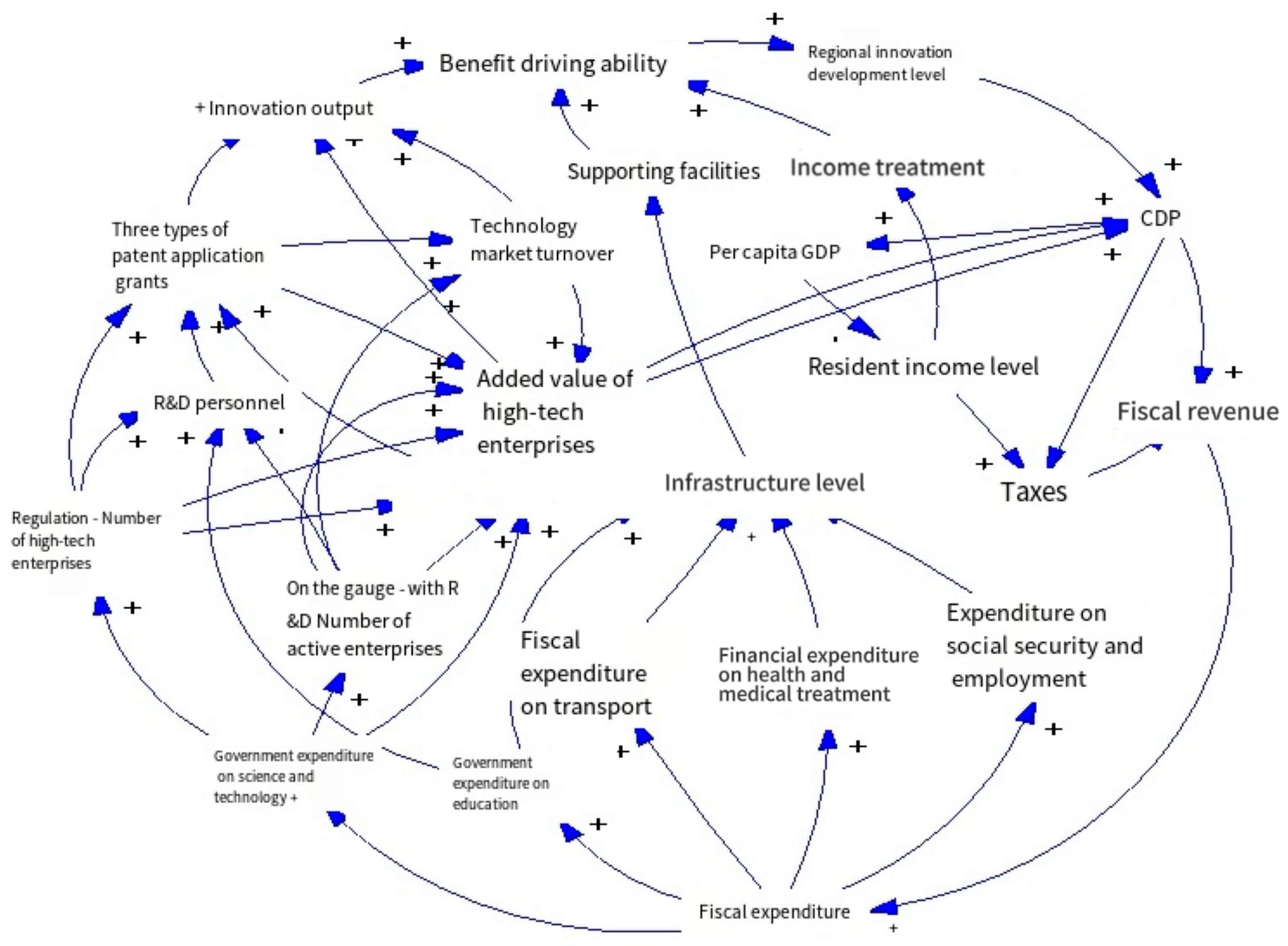
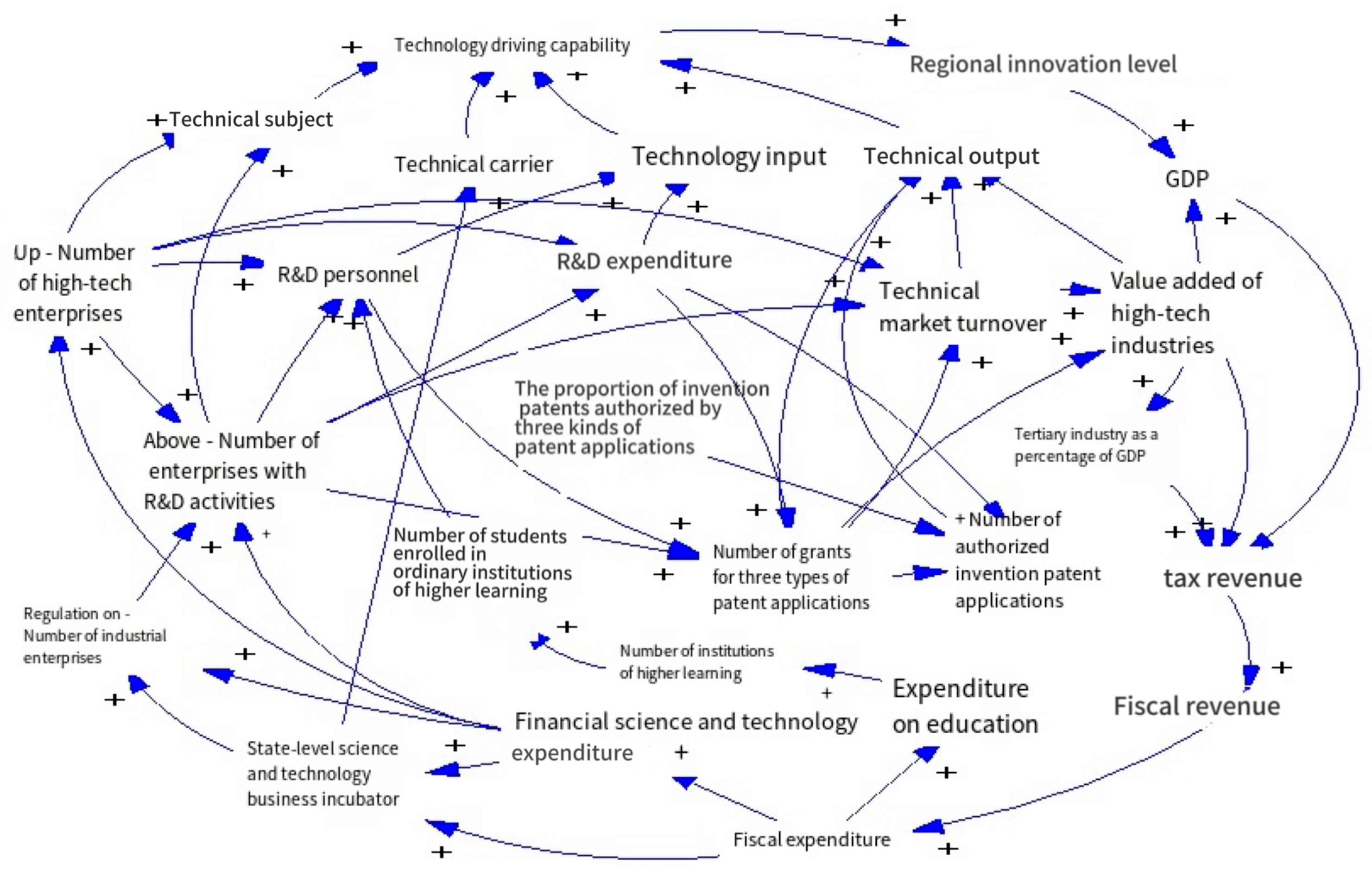
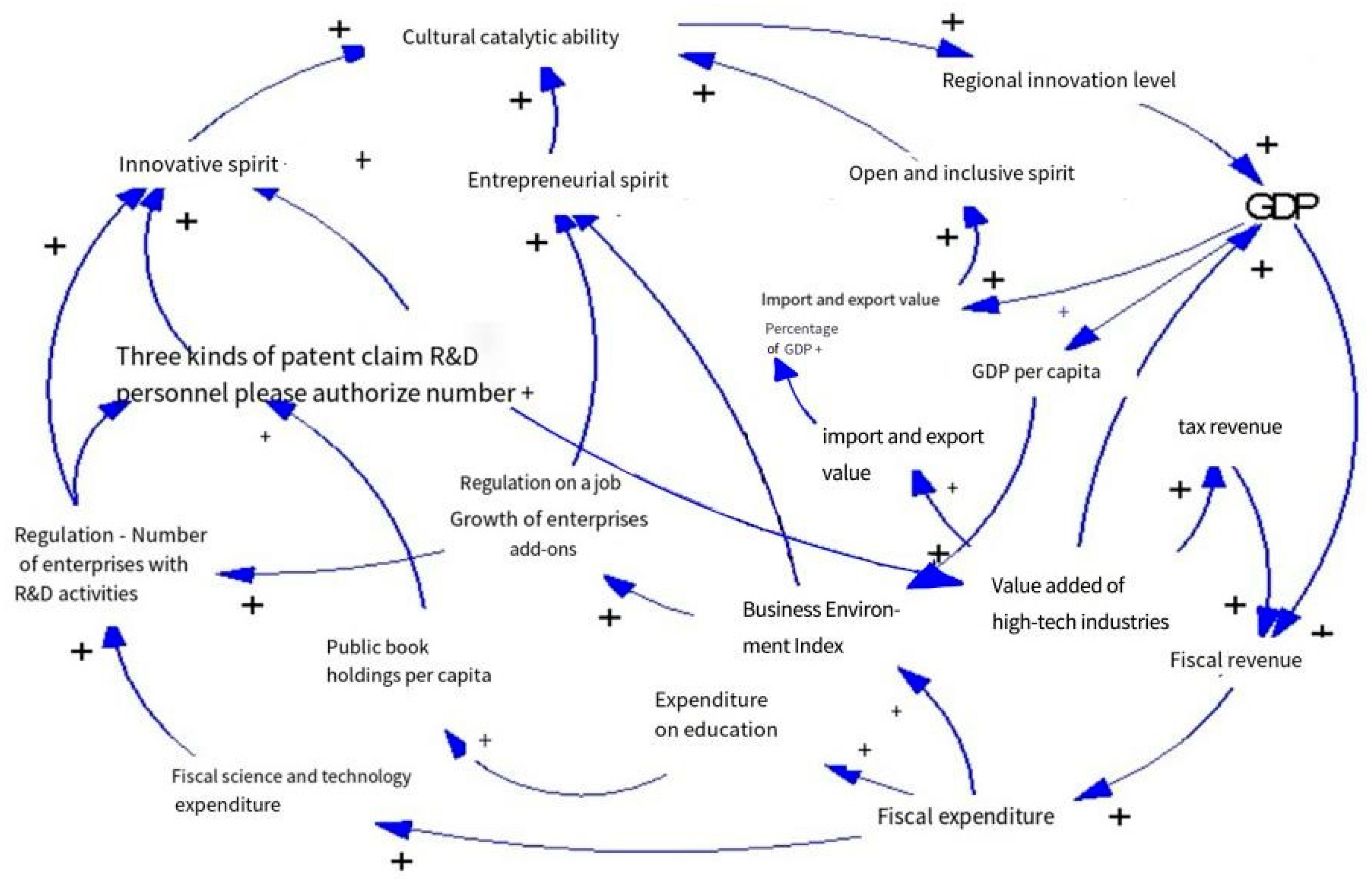
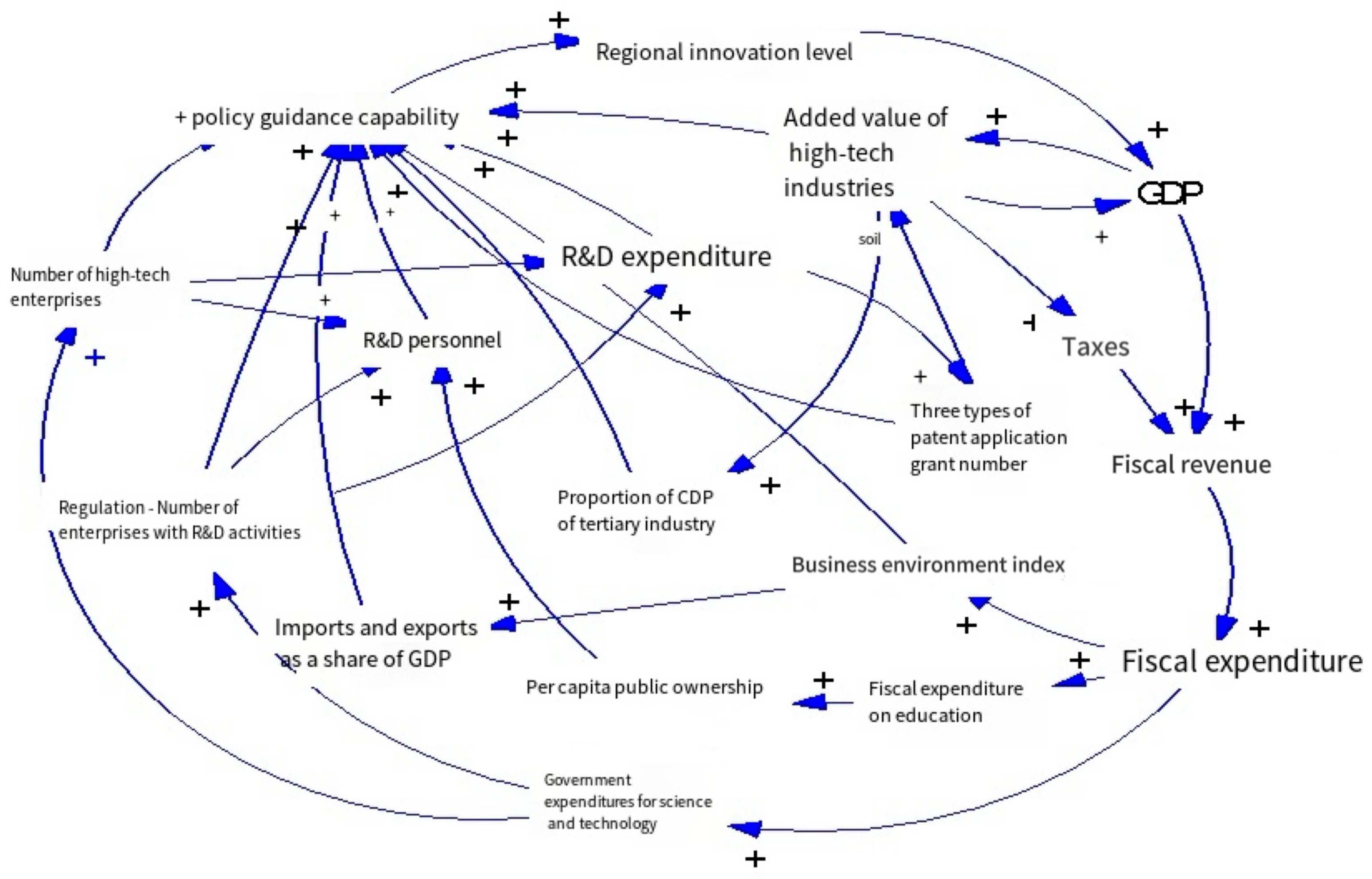
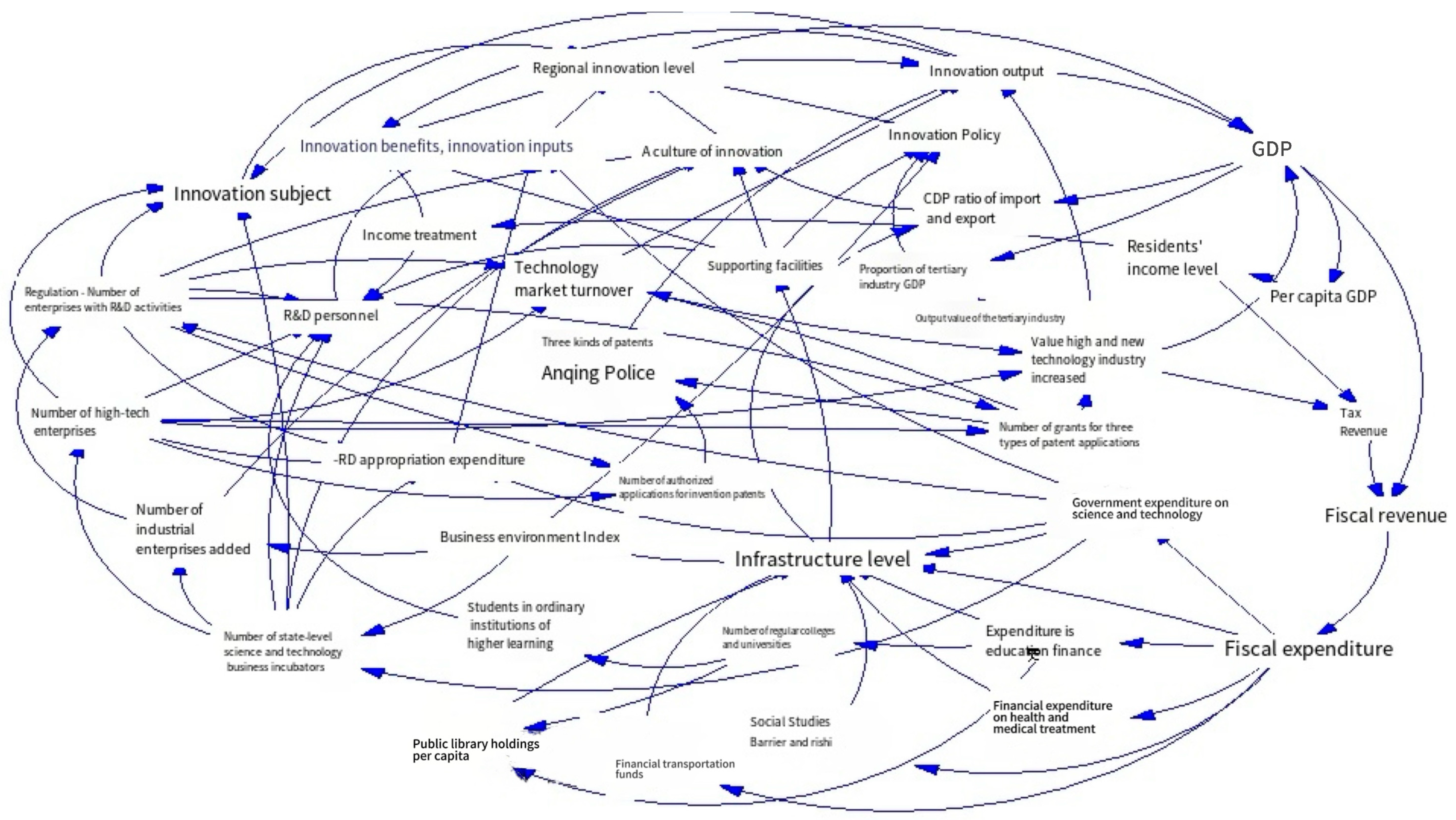


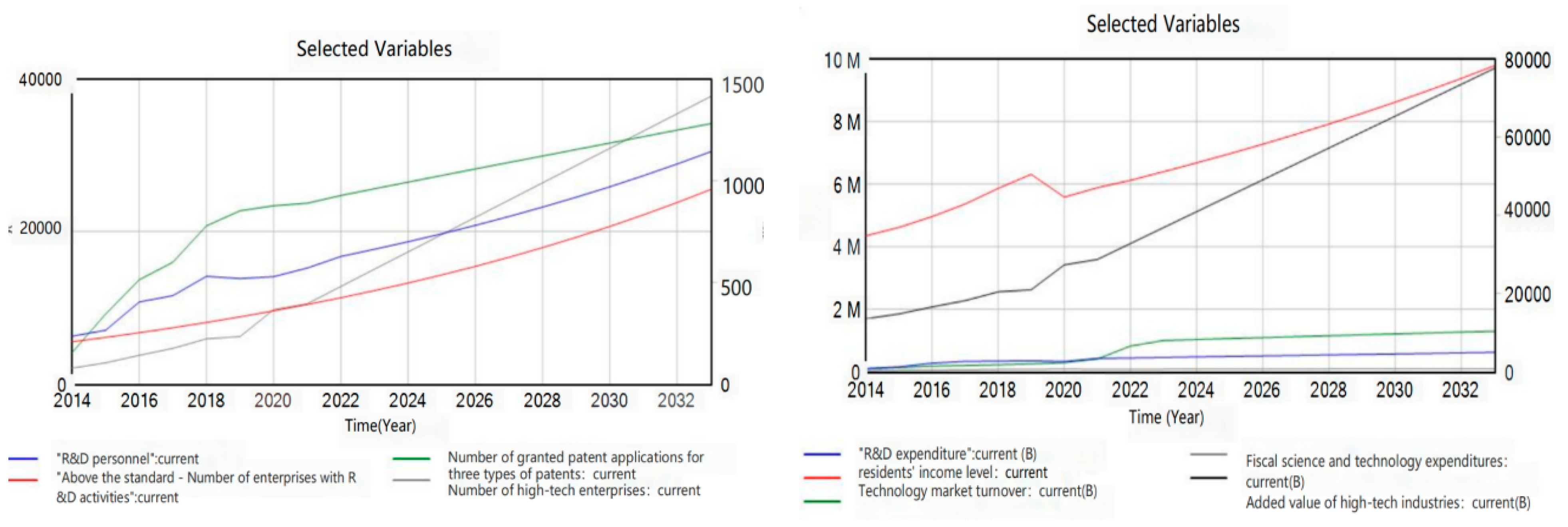
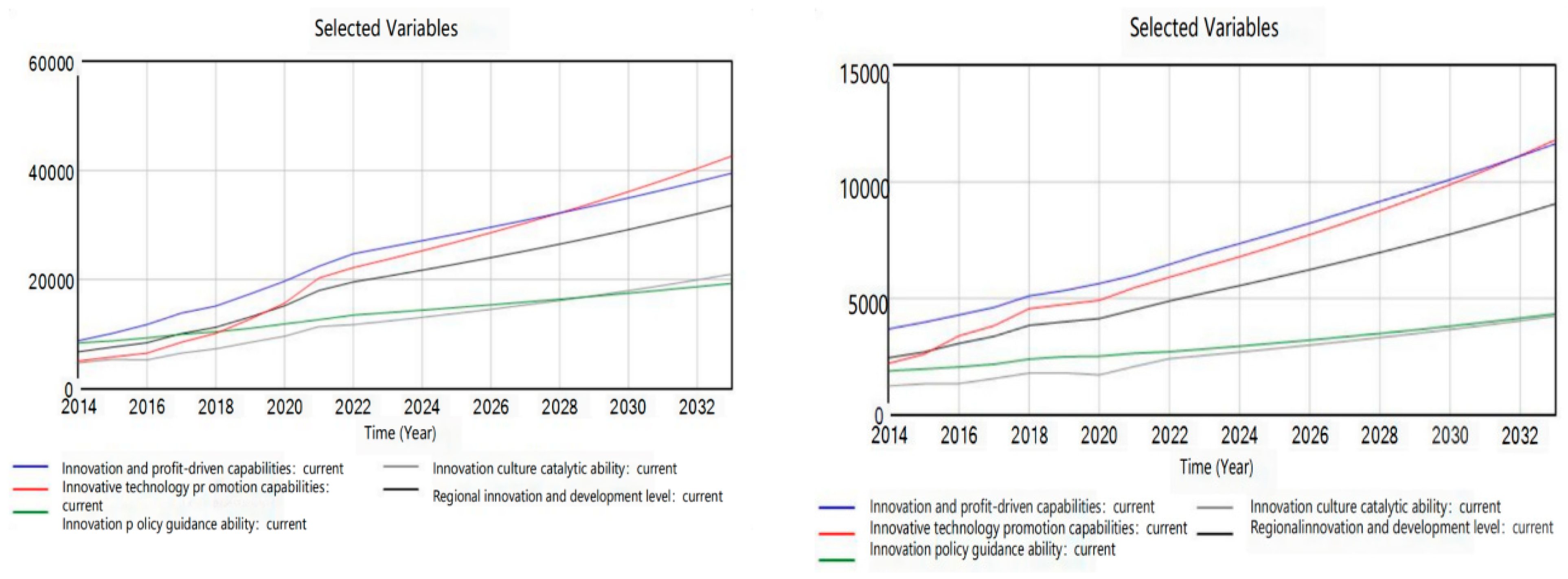
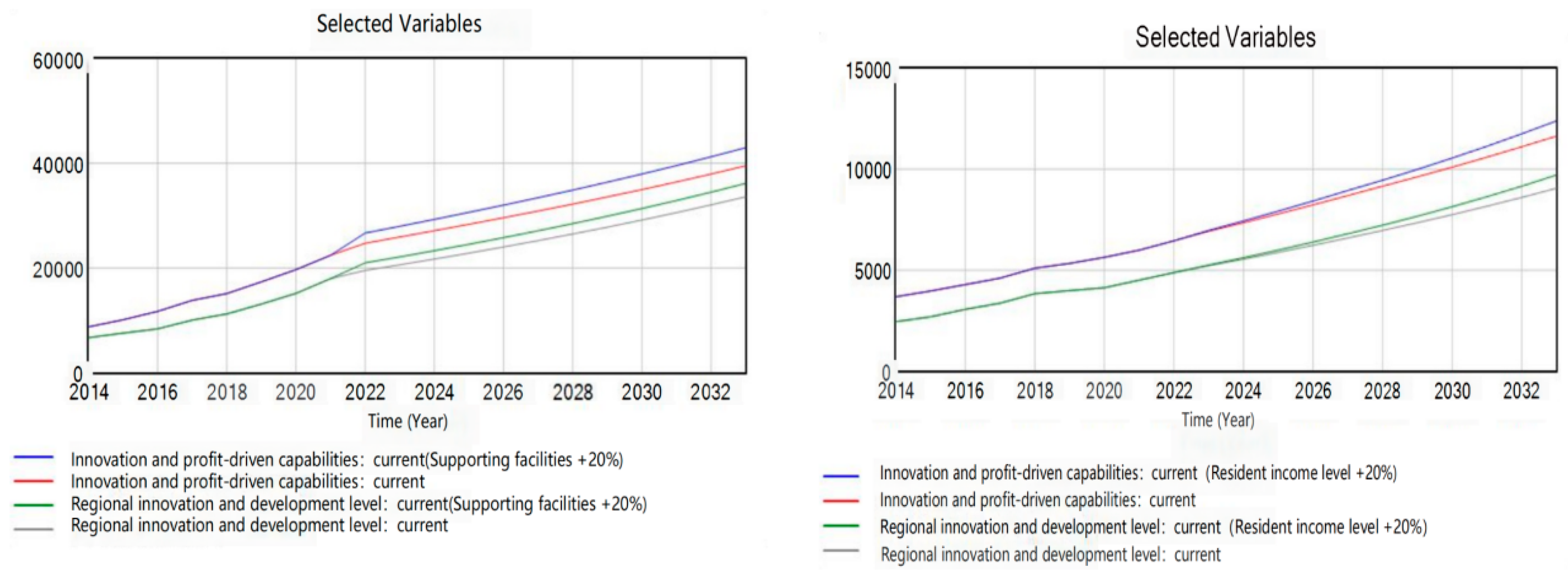












| Visual Angle | Definition | Main Point |
|---|---|---|
| Element composition theory | The regional innovation department covers various elements, such as government agencies, intermediary organizations, scientific research institutions, universities and enterprises, etc. There are certain connections and influences among these thematic elements. | ① Regional innovation system includes scientific research institutions, universities, government agencies, intermediary organizations, and other elements; ② The system with industrial cluster as the main body and innovation service system as the constituent element is the regional innovation system, whose fundamental goal is to cultivate regional industries and develop characteristic industrial clusters. |
| Complex system theory | Innovation is a complex system process with the participation of multiple actors and multiple links, which has the characteristics of open boundaries. | An innovation system space and organizational structure with open borders, a specific regional spatial scale, and a variety of innovation subject elements are covered. These subject units influence and function each other. In the process of playing the role of innovation, the system is influenced by the environment, its own organization, and the innovation structure, and can act on the ecological development and social economic development. |
| institutionalism | The regional innovation system is mainly a set of regional system that realizes the sustainable development of regional economy by means of technological innovation. | Innovation system is a new system composed of corresponding regional laws, regulations, and practices, which can serve the development of innovation. Regional system and corresponding institutional background play a very important role in the maintenance and emergence of regional innovation system. |
| Innovation network theory | The key to regional innovation system lies in an innovation network, which is composed of the interrelation between the main elements in the system. | ① Research on the network structure of regional innovation system; ② Research on the practice of regional innovation system based on the actual industrial cluster network; ③ Research on regional innovation system from a more complex perspective; ④ From the perspective of sociology, this paper hypothesizes (or empirically quantifies) the relationships among the subjects of the regional innovation system, and discusses the regional innovation system network. |
| Resource allocation theory | Regional innovation system belongs to the regional level of national innovation system, and is also an important method theory that can realize the optimal allocation of regional resources. | The regional innovation system has many similarities with the national innovation system in structure, which is composed of innovation infrastructure, innovation environment, innovation resources, and innovation implementation institutions. |
| Diffusion theory of technology | Technology diffusion system based on technology application and development is the essence of regional innovation system. | The Regional innovation system, a special organization that combines both private and public forms, can play an active role in promoting the development and application of technology. |
| Theoretical analysis frame theory | Regional innovation system is a new system framework to measure, detect, and guide the development of regional innovation. | In 2007, Bengt proposed a new conceptual analysis method and framework for national innovation systems, which also provided a reliable basis for the construction of the theoretical framework of regional innovation systems. |
| Variable Name | Variable Type | Unit | Variable Name | Variable Type | Unit |
|---|---|---|---|---|---|
| Total population | State variable | thousand | Number of institutions of higher learning | Auxiliary variable | |
| GDP | State variable | thousand | On the plan—there are R&D active industrial enterprises | Auxiliary variable | |
| Number of high-tech enterprises | State variable | Gauge—Number of industrial enterprises | State variable | ||
| Regional innovation and development capacity | State variable | Dmnl | Three types of authorization | Auxiliary variable | |
| Population growth | Rate variable | thousand | Number of authorized applications for invention patents | Auxiliary variable | |
| GDP growth | Rate variable | thousand | Three kinds of authorized invention patents accounted for | Auxiliary variable | |
| The number of high-tech enterprises increased | Rate variable | Technology market turnover | Auxiliary variable | thousand | |
| Innovation efficiency driving ability | State variable | Dmnl | Added value of high-tech industry | Auxiliary variable | thousand |
| The ability to promote scientific and technological innovation | State variable | Dmnl | Number of national science and technology enterprise incubators | Auxiliary variable | |
| Catalytic ability of innovation culture | State variable | Dmnl | R&D personnel | State variable | |
| Innovation policy guidance capacity | State variable | Dmnl | R&D expenditure | Auxiliary variable | thousand |
| Innovation input | Auxiliary variable | Dmnl | R&D funding intensity | Auxiliary variable | % |
| Innovation income | Auxiliary variable | Dmnl | Per capita disposable income | State variable | |
| Innovation output | Auxiliary variable | Dmnl | Per capita GDP | Auxiliary variable | |
| Import and export | Auxiliary variable | thousand | Share of import and export GDP | Auxiliary variable | % |
| Output value of tertiary industry | Auxiliary variable | thousand | The proportion of tertiary industry GDP | Auxiliary variable | % |
| Resident income level | Auxiliary variable | Supporting facilities | Auxiliary variable | Dmnl | |
| revenue | Auxiliary variable | thousand | Fiscal revenue | Auxiliary variable | thousand |
| Fiscal expenditure | Auxiliary variable | thousand | Business environment index | Auxiliary variable | Dmnl |
| Science and technology expenditure as a proportion of government expenditure | Auxiliary variable | % | Government expenditure on science and technology | Auxiliary variable | thousand |
| Education appropriation as a proportion of government expenditure | Auxiliary variable | % | Financial expenditure on education | Auxiliary variable | thousand |
| Transport expenditure as a proportion of fiscal expenditure | Auxiliary variable | % | Fiscal expenditure on transport | Auxiliary variable | thousand |
| The proportion of health and medical expenditure to fiscal expenditure | Auxiliary variable | % | Financial expenditure on health and medical treatment | Auxiliary variable | thousand |
| Expenditure on social security and employment as a proportion of government expenditure | Auxiliary variable | % | Fiscal expenditure on social security and employment | Auxiliary variable | thousand |
| Personnel growth rate | Auxiliary variable | % | Population growth rate | Auxiliary variable | % |
| Disposable income growth rate | Auxiliary variable | % | Public library stock | Auxiliary variable | thousand |
| Enterprise growth rate | constant | % | R&D personnel growth | Rate variable | |
| Growth rate of industrial enterprises | Rate variable |
| Central City | Non-Central City | ||
|---|---|---|---|
| index | Influence degree (%) | index | Influence degree (%) |
| Growth rate of industrial enterprises | 6.79 | R&D funding intensity | 8.75 |
| Resident income level | 6.2 | The number of high-tech enterprises increased | 8.28 |
| The proportion of invention patents granted | 5.9 | Growth rate of industrial enterprises | 8.21 |
| The number of high-tech enterprises increased | 5.74 | Level of supporting facilities | 7.63 |
| Level of supporting facilities | 5.61 | Resident income level | 7.26 |
| Number of science and technology incubators | 5.37 | R D personnel growth rate | 6.14 |
| R&D funding intensity | 4.46 | The proportion of tertiary industry | 5.68 |
| R&D personnel growth rate | 3.43 | The proportion of invention patents granted | 5.2 |
| The proportion of tertiary industry | 3.09 | Number of science and technology incubators | 4.16 |
| Government expenditure on science and technology | 2.2 | Government expenditure on science and technology | 3.06 |
| Share of import and export GDP | 1.64 | Share of import and export GDP | 1.54 |
Disclaimer/Publisher’s Note: The statements, opinions and data contained in all publications are solely those of the individual author(s) and contributor(s) and not of MDPI and/or the editor(s). MDPI and/or the editor(s) disclaim responsibility for any injury to people or property resulting from any ideas, methods, instructions or products referred to in the content. |
© 2024 by the authors. Licensee MDPI, Basel, Switzerland. This article is an open access article distributed under the terms and conditions of the Creative Commons Attribution (CC BY) license (https://creativecommons.org/licenses/by/4.0/).
Share and Cite
Hou, R.; Xiao, J.; Zhu, B.; Peng, W.; Dan, H. Research on the Optimization Path of Regional Innovation “Dualization” Effect Based on System Dynamics. Sustainability 2024, 16, 4869. https://doi.org/10.3390/su16114869
Hou R, Xiao J, Zhu B, Peng W, Dan H. Research on the Optimization Path of Regional Innovation “Dualization” Effect Based on System Dynamics. Sustainability. 2024; 16(11):4869. https://doi.org/10.3390/su16114869
Chicago/Turabian StyleHou, Renyong, Jiaxing Xiao, Baoji Zhu, Weihua Peng, and Haijian Dan. 2024. "Research on the Optimization Path of Regional Innovation “Dualization” Effect Based on System Dynamics" Sustainability 16, no. 11: 4869. https://doi.org/10.3390/su16114869
APA StyleHou, R., Xiao, J., Zhu, B., Peng, W., & Dan, H. (2024). Research on the Optimization Path of Regional Innovation “Dualization” Effect Based on System Dynamics. Sustainability, 16(11), 4869. https://doi.org/10.3390/su16114869





